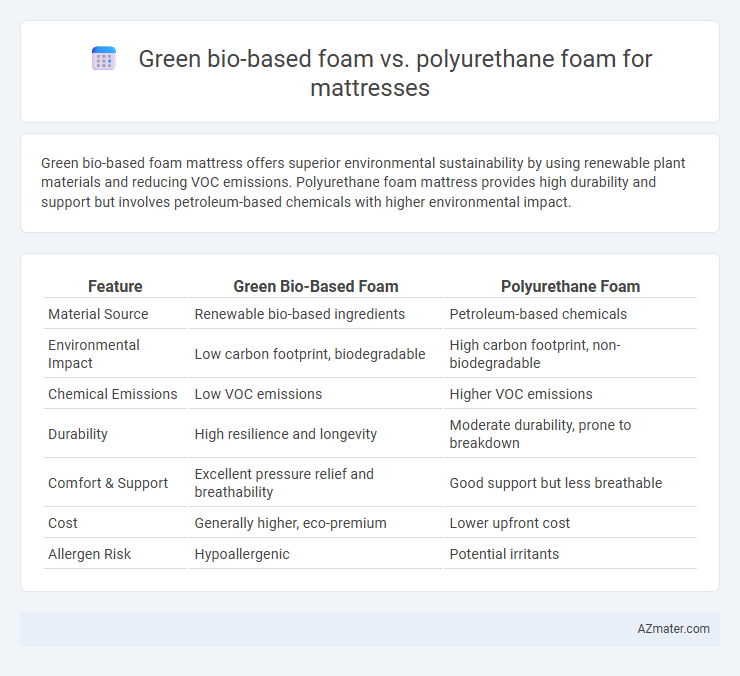Green bio-based foam mattress offers superior environmental sustainability by using renewable plant materials and reducing VOC emissions. Polyurethane foam mattress provides high durability and support but involves petroleum-based chemicals with higher environmental impact.
Table of Comparison
| Feature | Green Bio-Based Foam | Polyurethane Foam |
|---|---|---|
| Material Source | Renewable bio-based ingredients | Petroleum-based chemicals |
| Environmental Impact | Low carbon footprint, biodegradable | High carbon footprint, non-biodegradable |
| Chemical Emissions | Low VOC emissions | Higher VOC emissions |
| Durability | High resilience and longevity | Moderate durability, prone to breakdown |
| Comfort & Support | Excellent pressure relief and breathability | Good support but less breathable |
| Cost | Generally higher, eco-premium | Lower upfront cost |
| Allergen Risk | Hypoallergenic | Potential irritants |
Introduction to Foam Materials for Mattresses
Green bio-based foam for mattresses is derived from renewable plant-based materials, offering an eco-friendly alternative to conventional polyurethane foam, which is primarily petroleum-based. Bio-based foams provide unique benefits such as reduced environmental impact, enhanced breathability, and improved biodegradability. Polyurethane foam remains popular due to its versatility, durability, and supportive comfort but faces sustainability challenges that green bio-based foams seek to address.
What is Green Bio-Based Foam?
Green bio-based foam is a sustainable alternative to traditional polyurethane foam, derived primarily from natural materials such as soy, castor oil, or other plant-based oils. It offers comparable comfort and durability while reducing reliance on petroleum-based resources and lowering environmental impact through biodegradability and renewable sourcing. Compared to conventional polyurethane foam, green bio-based foam typically emits fewer volatile organic compounds (VOCs), enhancing indoor air quality in mattresses.
Understanding Polyurethane Foam
Polyurethane foam, widely used in mattresses, offers excellent support and durability due to its synthetic polymer structure derived from petrochemicals. This foam provides customizable firmness and resilience, making it a popular choice for various sleep preferences. However, concerns about VOC emissions and environmental impact have driven interest in green bio-based foam alternatives with renewable materials and lower ecological footprints.
Environmental Impact: Bio-Based vs Polyurethane
Green bio-based foam mattresses significantly reduce environmental impact by utilizing renewable resources such as plant oils, which lower carbon emissions and limit reliance on fossil fuels. In contrast, traditional polyurethane foam production involves petrochemical processes that generate more greenhouse gases and contribute to non-biodegradable waste accumulation. The biodegradability and lower toxicity of bio-based foam enhance sustainable waste management, making it a preferred choice for eco-conscious consumers.
Comfort and Performance Comparison
Green bio-based foam offers superior breathability and moisture-wicking properties compared to traditional polyurethane foam, enhancing overall sleep comfort by regulating temperature more effectively. Polyurethane foam provides excellent support and durability, but often retains heat, leading to discomfort during prolonged use. The eco-friendly composition of green bio-based foam also reduces off-gassing and allergen presence, contributing to a healthier sleeping environment without compromising performance.
Durability and Lifespan Analysis
Green bio-based foam mattresses demonstrate enhanced durability due to their superior resistance to compression and natural material resilience, often outlasting traditional polyurethane foam by 20-30%. Polyurethane foam, while initially offering strong support, tends to degrade faster under regular use, showing visible signs of wear such as sagging and loss of firmness within 5-7 years. Lifecycle assessments confirm that bio-based foams maintain structural integrity longer, reducing the need for frequent replacements and supporting sustainable consumption in mattress production.
Health and Safety Considerations
Green bio-based foam mattresses use natural plant-derived oils, reducing exposure to harmful volatile organic compounds (VOCs) and synthetic chemicals commonly found in polyurethane foam. These foams typically offer better breathability and hypoallergenic properties, lowering the risk of respiratory irritation and allergic reactions. Polyurethane foam may emit off-gassing chemicals such as formaldehyde and isocyanates, which can pose long-term health risks including asthma and chemical sensitivities.
Cost Effectiveness and Availability
Green bio-based foam offers moderate cost effectiveness with prices typically 10-20% higher than conventional polyurethane foam but benefits from rising demand and sustainable sourcing that may reduce long-term expenses. Polyurethane foam remains widely available and cost-efficient due to mass production and mature supply chains, making it a preferred choice for budget-conscious manufacturers. Increasing availability of bio-based raw materials is gradually improving the market presence of green foam, though it still lags behind polyurethane in large-scale accessibility.
Consumer Trends and Market Demand
Green bio-based foam is gaining traction in the mattress market, driven by rising consumer demand for sustainable and non-toxic materials. Polyurethane foam remains popular due to its durability and affordability, but concerns over chemical emissions are steering eco-conscious buyers towards plant-based alternatives. Market trends indicate a significant increase in bio-based foam adoption, fueled by environmental awareness and stricter regulations on synthetic foam components.
Which Foam is Better for Mattresses?
Green bio-based foam offers superior environmental benefits and enhanced breathability compared to traditional polyurethane foam, making it an ideal choice for eco-conscious consumers. Polyurethane foam typically provides higher durability and support, which can translate to longer mattress lifespan and better pressure relief. When choosing the best foam for mattresses, balancing sustainability with performance requirements is key, with green bio-based foam excelling in natural composition and polyurethane foam leading in structural reliability.

Infographic: Green bio-based foam vs Polyurethane foam for Mattress
 azmater.com
azmater.com